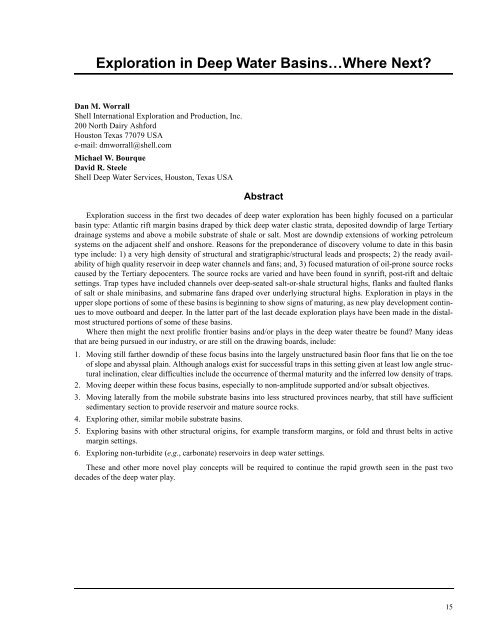Petroleum Systems of Deep-Water Basins - Gulf Coast Section SEPM
Petroleum Systems of Deep-Water Basins - Gulf Coast Section SEPM
Petroleum Systems of Deep-Water Basins - Gulf Coast Section SEPM
You also want an ePaper? Increase the reach of your titles
YUMPU automatically turns print PDFs into web optimized ePapers that Google loves.
Exploration in <strong>Deep</strong> <strong>Water</strong> <strong>Basins</strong>…Where Next?<br />
Dan M. Worrall<br />
Shell International Exploration and Production, Inc.<br />
200 North Dairy Ashford<br />
Houston Texas 77079 USA<br />
e-mail: dmworrall@shell.com<br />
Michael W. Bourque<br />
David R. Steele<br />
Shell <strong>Deep</strong> <strong>Water</strong> Services, Houston, Texas USA<br />
Abstract<br />
Exploration success in the first two decades <strong>of</strong> deep water exploration has been highly focused on a particular<br />
basin type: Atlantic rift margin basins draped by thick deep water clastic strata, deposited downdip <strong>of</strong> large Tertiary<br />
drainage systems and above a mobile substrate <strong>of</strong> shale or salt. Most are downdip extensions <strong>of</strong> working petroleum<br />
systems on the adjacent shelf and onshore. Reasons for the preponderance <strong>of</strong> discovery volume to date in this basin<br />
type include: 1) a very high density <strong>of</strong> structural and stratigraphic/structural leads and prospects; 2) the ready availability<br />
<strong>of</strong> high quality reservoir in deep water channels and fans; and, 3) focused maturation <strong>of</strong> oil-prone source rocks<br />
caused by the Tertiary depocenters. The source rocks are varied and have been found in synrift, post-rift and deltaic<br />
settings. Trap types have included channels over deep-seated salt-or-shale structural highs, flanks and faulted flanks<br />
<strong>of</strong> salt or shale minibasins, and submarine fans draped over underlying structural highs. Exploration in plays in the<br />
upper slope portions <strong>of</strong> some <strong>of</strong> these basins is beginning to show signs <strong>of</strong> maturing, as new play development continues<br />
to move outboard and deeper. In the latter part <strong>of</strong> the last decade exploration plays have been made in the distalmost<br />
structured portions <strong>of</strong> some <strong>of</strong> these basins.<br />
Where then might the next prolific frontier basins and/or plays in the deep water theatre be found? Many ideas<br />
that are being pursued in our industry, or are still on the drawing boards, include:<br />
1. Moving still farther downdip <strong>of</strong> these focus basins into the largely unstructured basin floor fans that lie on the toe<br />
<strong>of</strong> slope and abyssal plain. Although analogs exist for successful traps in this setting given at least low angle structural<br />
inclination, clear difficulties include the occurrence <strong>of</strong> thermal maturity and the inferred low density <strong>of</strong> traps.<br />
2. Moving deeper within these focus basins, especially to non-amplitude supported and/or subsalt objectives.<br />
3. Moving laterally from the mobile substrate basins into less structured provinces nearby, that still have sufficient<br />
sedimentary section to provide reservoir and mature source rocks.<br />
4. Exploring other, similar mobile substrate basins.<br />
5. Exploring basins with other structural origins, for example transform margins, or fold and thrust belts in active<br />
margin settings.<br />
6. Exploring non-turbidite (e.g., carbonate) reservoirs in deep water settings.<br />
These and other more novel play concepts will be required to continue the rapid growth seen in the past two<br />
decades <strong>of</strong> the deep water play.<br />
15

















